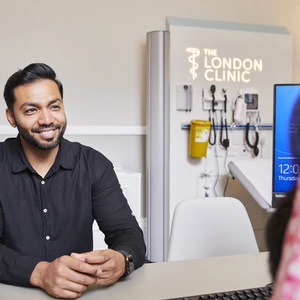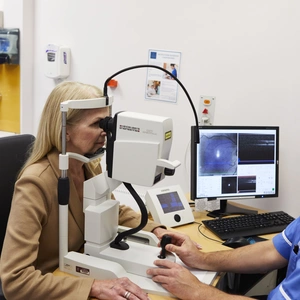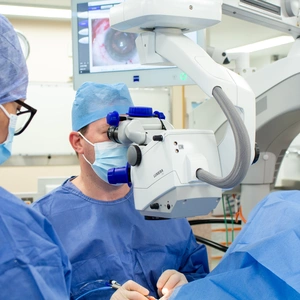Cataracts
Cataracts are a common feature of ageing and develop as the natural lens in the eye becomes cloudy over time. Most people begin to experience some degree of cataract development in their 60s, with around one in three individuals over 65 affected in the UK.
Cataracts can occur in one or both eyes, and symptoms often worsen gradually. While initially manageable with stronger glasses or brighter lighting, advanced cataracts may require surgical intervention.
Cataract symptoms
In the early stages, cataracts may not cause noticeable symptoms. However, as they progress, you may experience:
- Gradual decline in vision, which can affect near vision, distance vision, or both.
- Ghosting in vision – seeing a shadow around objects or double vision in one eye.
- Blurred or dim vision.
- Seeing ‘halos’ around lights.
- Difficulty seeing at night.
- Frequent changes in your glasses or contact lens prescription.
- Glare and increasing sensitivity to light.
- Needing a brighter light for reading.
- Colours appearing faded or dull; difficulty distinguishing some colours, such as blue and black.
What causes cataracts?
Cataracts are most commonly caused by ageing, as the natural lens fibres in the eye gradually break down and become cloudy over time. While this process is normal, genetic factors can sometimes lead to cataracts developing earlier, even in people in their 40s or 50s. Other contributing factors include lifestyle choices, medical conditions, and previous eye injuries or surgeries:
- Smoking
- Diabetes
- Excessive sunlight (UV) exposure
- Obesity
- Family history of cataracts
- Previous eye injury
- Previous eye surgery, including glaucoma or retinal detachment procedures
- Inflammation (uveitis)
- Long-term use of steroids or certain other medications
- Inherited conditions
- Alcohol abuse
Frequently asked questions (FAQs)
You can reduce your risk of developing a cataract by:
- Having regular eye exams, so any potential problems can be identified early
- Quitting smoking
- Eating a healthy, balanced diet which includes plenty of fruits and vegetables
- Wearing sunglasses to avoid damage from ultraviolet light
- Limiting your consumption of alcohol
Cataract surgery is one of the most commonly performed and successful surgeries in the UK. It has a 95% success rate for improving vision, provided there are no other eye conditions. While glasses may still be required for reading or distance vision after the procedure, most patients achieve significantly improved clarity.
Minor Complications: About 5% of patients experience minor complications, such as a longer recovery time or an unexpected glasses prescription due to slight inaccuracies in pre-surgery measurements (biometry). Dry eye, which may worsen temporarily after surgery, is another common issue (up to 10% of patients). Symptoms often improve within a few months with lubrication drops.
Serious Complications: Although rare, there are risks of infection (1–2 per 1,000), bleeding (less than 1 in 1,000), retinal detachment (1 in 250), or corneal damage (less than 1 in 100). In very rare cases, circulatory issues in the retina may occur (less than 1 in 3,000).
Overall, the chance of severe complications is very low (around 1 in 1,000), but all risks will be carefully explained by your surgeon before the procedure.
Before your surgery, a non-invasive test called biometry will be performed to measure the dimensions of your eyes. This helps calculate the strength of the lens implant you’ll need for optimal vision after the procedure.
Your consultant will provide clear guidance on any preparations, such as stopping certain medications, to ensure a smooth surgery.
Cataract surgery replaces your cloudy natural lens with a clear artificial lens, called an intraocular lens implant. This implant can often reduce or even eliminate your need for glasses.
Several lens options are available, depending on your lifestyle, visual needs, and overall eye health. Your consultant will help you decide the best option for you:
- Distance Lens: Designed for clear vision at a distance, this option is ideal for activities like driving or watching TV. You’ll still need glasses for reading or computer work.
- Reading Lens: This lens is best for those who spend most of their time reading or doing close-up tasks. You’ll still need glasses for distance activities like walking or driving.
- Monovision: If both eyes need cataract surgery, one eye can be set for distance and the other for reading. This approach works well for many patients, providing greater glasses independence for everyday activities. However, some patients may need time to adapt or opt for adjustments like contact lenses or further treatment.
- Multifocal Lens: These advanced lenses reduce dependency on glasses by improving vision at three distances: near, intermediate (e.g., computer use), and far. While most patients adjust well, some notice glare or halos around lights, especially at night. These effects are generally mild and improve over time.
- Extended Depth of Field (EDOF) Lens: A newer technology that enhances distance and middle vision with minimal glare or halos compared to multifocal lenses. You may still need reading glasses for small print or prolonged close-up tasks.
- Toric Lens for Astigmatism: If you have astigmatism, this lens can correct the curvature of your cornea for clearer vision. Multifocal and EDOF lenses are also available as toric variants. In rare cases, the lens may rotate after surgery, requiring a simple adjustment.
Your consultant will discuss the pros and cons of each lens and guide you toward the most suitable choice for your needs.
Cataract surgery typically takes 20–30 minutes and is performed as a day-case procedure. During the surgery, your surgeon will make a small incision in your eye, break up the cloudy lens (cataract), and remove it using a technique called phacoemulsification. The lens is then replaced with an artificial intraocular lens (IOL) tailored to your prescription. Most procedures are done under local anaesthetic, and sedation can be offered to help you relax.
Arrival and Preparation:
On the day of your cataract surgery, you’ll arrive at the clinic 2–3 hours before the procedure. A nurse will take your medical history, check your medications, and measure your blood pressure. Your eye will be dilated using drops or a pellet under the eyelid to allow the surgeon better access to the cataract. Your surgeon will mark the eye to be operated on and answer any final questions you may have.
During the Procedure:
The surgery is typically painless and takes 20–30 minutes. Your operated eye will be numbed with anaesthetic, which limits your vision, while your other eye will be covered with a frosted drape for comfort. You won’t see any instruments approaching your eye. Instead, most patients report seeing sparkling lights or colour patterns during the procedure.
Can both eyes be operated on at the same time?
In certain cases, both eyes can be treated in a single session, known as immediate sequential bilateral cataract surgery (ISBCS). This is less common and only recommended for straightforward cataracts with minimal risk of complications. Your surgeon will carefully assess your suitability and discuss the pros and cons with you.
After Surgery:
Following the procedure, your eye may feel mildly irritated or sensitive. It will be protected with either a clear shield or a patch, which you’ll be advised to remove the following morning. You may experience temporary blurred vision, light sensitivity, or mild discomfort, but these symptoms typically improve within a few days.
Getting Home:
It’s recommended, but not essential, to have a friend or relative accompany you home. While it’s possible to use public transport, many patients prefer traveling by car, minicab, or taxi for convenience, especially if they’ve had sedation.
What is the recovery process like?
Most patients go home 1–2 hours after surgery. You’ll need to avoid strenuous activities for 2–4 weeks and follow your surgeon’s aftercare advice. Most people return to work within a week, depending on their job, and achieve improved vision as healing progresses.
What should I do if I experience post-operative complications?
While rare, serious complications can occur, such as infection, excessive redness, severe pain, or a sudden change in vision. If you experience any of these symptoms, contact your ophthalmologist immediately for urgent advice.
























